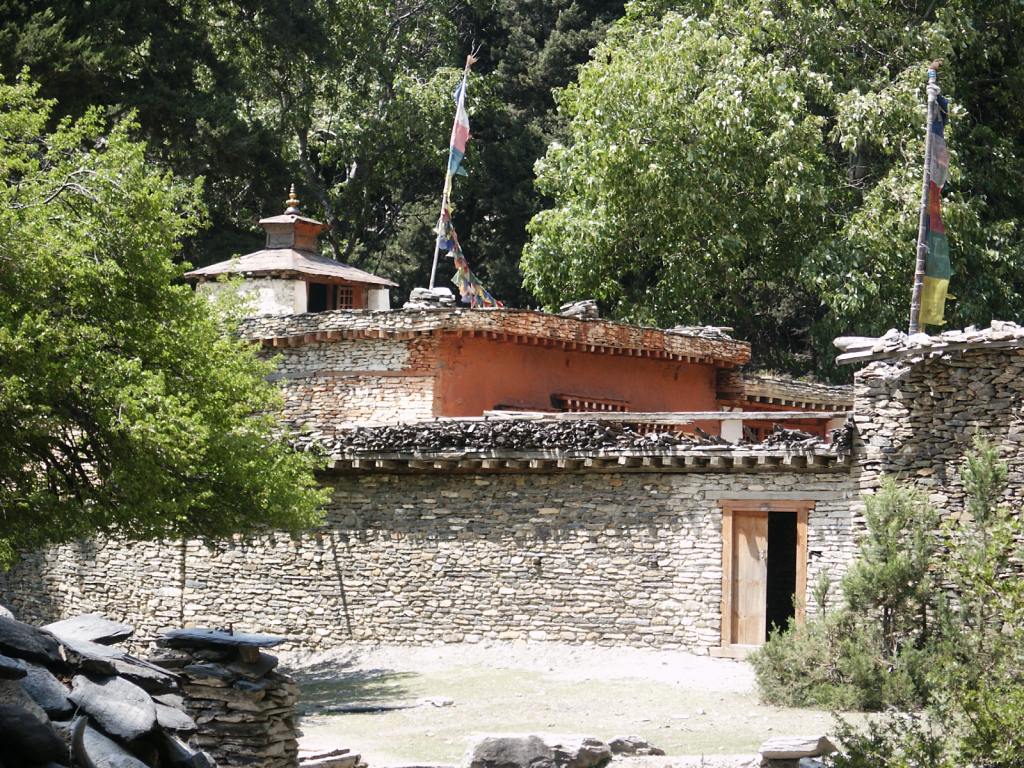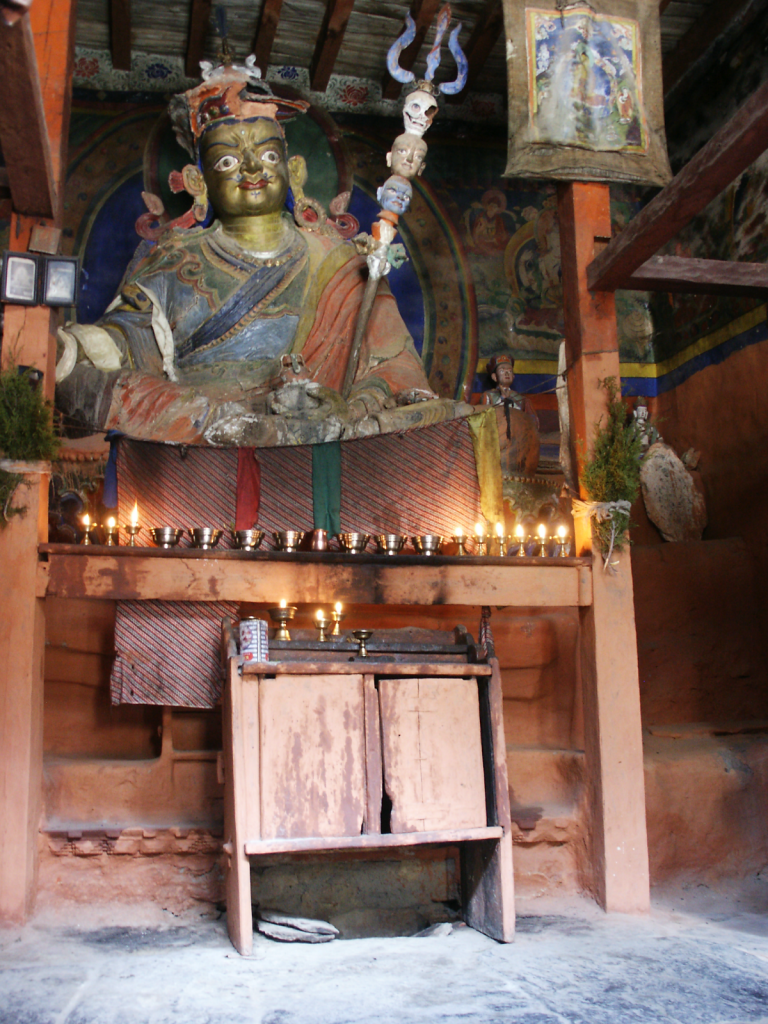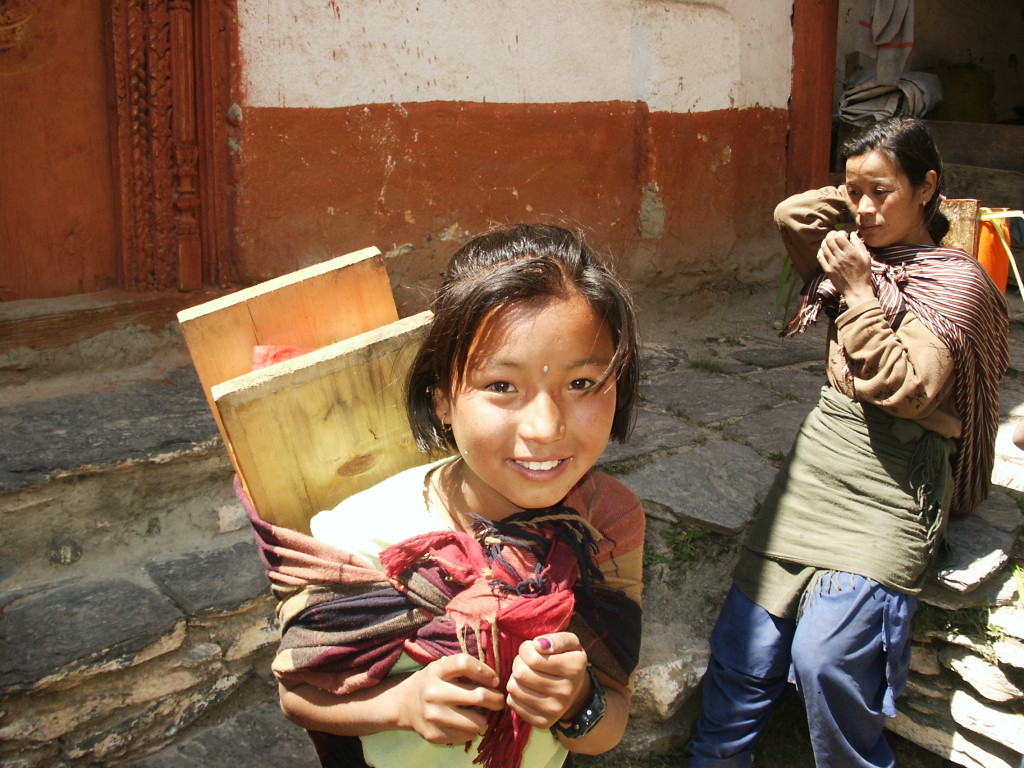May 4, 2004 – Chhairo, Mustang
Buddha’s 2548th Birthday
Last week was Buddha’s birthday. This was significant here because while Nepal is the world’s only official Hindu kingdom, the district of Mustang is mostly Buddhist. Given the predominance of Buddhism, I must admit that I was rather disappointed in the effort that I saw when the day itself came.
The entirety of the Buddha Jayanti consisted of our school children parading through the village (which, mind you, is the size of an American city block) behind the head student who carried a cardboard picture of Buddha as he marched. Then one of the teachers would shout something that I didn’t understand and the students would shout something back which I also didn’t understand, while they pumped their fists in the air (all except the head student whose fists were occupied with the cardboard and crayon figure of Buddha). The entire parade lasted less than ten minutes as our village is very small (yes, really, the size of only one city block).
After returning to school, the teacher gave a short speech about being virtuous and then dismissed the students for the rest of the day. That was it. Rather disappointing.
 Two days later, however, I came across the majority of the student body (about 30 of the 35 children who comprise the student body) leaving school at the midday recess. They were headed to the gumpa (monastery/temple) to celebrate Buddha’s birthday again.
Two days later, however, I came across the majority of the student body (about 30 of the 35 children who comprise the student body) leaving school at the midday recess. They were headed to the gumpa (monastery/temple) to celebrate Buddha’s birthday again.
“Why didn’t we do this two days ago?” I asked.
“Because the lama (monk) was busy doing ceremonies in the other villages.”
Seeing as Chhairo is so small (did I mention it is only about one city block big?), our turn didn’t come around until two days after the actual celebrated date of Buddha’s birthday. But now that the lama was here, we were to celebrate.
“Do you want to come with us, Nathan-sir?”
“Well, I guess I’m not teaching anymore today – all my students are gone – so, yes, I’ll go with you.”
As we walked the kids asked me if I was going to carry a book. Not having a clue as to what they meant, I said that I didn’t know. They must have said something that only sounded like ‘carry a book,’ which must have been some religious term that only sounded like ‘carry a book.’ Then they asked if I had a blanket. No, I didn’t normally come to school with a blanket, so I didn’t have one. That was alright, because Krishna, one of my fifth-graders had an extra which I could use. For what, I again had no idea. Then they asked me if I had some rice. This whole thing was getting stranger and stranger. No, I didn’t have any rice either. So they all reached into their pockets and pulled out handfuls of rice. Then they each gave me a little bit until I had my own handful of rice to put in my pocket. Bizarre. But that is the way that most things have gone here in Nepal. I just smile and go along, not having any understanding or foreknowledge of where it is that I am going. But so far it has worked out alright because usually when I get there, wherever ‘there’ is, it turns out to be not so bad.
So we went to the gumpa. Now the Chhairo gumpa is one of the oldest in Mustang. According to the locals only the Dumpa gumpa is older. I don’t know about this, but I do know that the newest part of the Chhairo gumpa is more than 300 years old. The oldest part is much, much older than that. The building is made of skillfully piled stones. In some places, these stones were then covered in mud. In others, they were left bare. The whole building is roughly a square shape of about 150 feet to a side. Inside there are a couple of courtyards, temples and various rooms to cook, do puja (worship), live, and dry your laundry when ceremonies aren’t taking place. One of the walls on the older section has bowed outwards precariously, with the rocks crumbling away with the passage of centuries, leaving a giant mouth-like hole with bad dental work in the middle of the wall. Inside stones and wooden beams have been placed to prevent the spread of this slow decay, but they are only a stop-gap measure at best. On this day, the main courtyard of the gumpa was filled with most of my villagers, sunlight and smoke from the burning cedar boughs of a sacred fire. Men and women, adults and children were all milling around in various stages of ceremony. Three of my students led me into the gumpa and then it was my turn to be the student as they walked me through their ritual celebration. First, throw the rice from your pockets in three handfuls (numbers are very important in their Buddhism, three being one of the best numbers, that and 108) at the foot of the fierce looking statue with the spear in his hand that is adorned with skulls – he is the supreme bhagwan (god), and it’s better if you stay in his good graces. Next place your hands together and do a ‘namaste’ with the bowing of your head. This is how Nepalis greet each other. Then kneel down, place your hands on the ground before you and then touch your forehead to the earth. Stand up again and repeat this two more times (a total of three).
 After paying proper tributes to the bhagwan, we went into the next room where three lamas (including the head monk who was busy the last two days doing his rounds) were seated on the ground with their sacred texts open before them. The only light in this part of the gumpa came from two sources: a skylight hole in the ceiling whose shaft of light shone directly down on the monks; and the hundreds of oil candles they had lit and placed at the foot of the painting of Buddha that anchored a 360 degree mosaic that covered the entirety of all four walls. In the mural were all the gods of Tibetan Buddhism – the Green and White Taras, the goddesses of night and day, the Guru Rimpoche who had brought Buddhism to Tibet 800 years ago, and many more that my 13 year old guides didn’t know. The room was filled with the incessant murmurings of the monks, an endless stream of holy Tibetan mutterings that were punctuated by strikes on the holy hand-drums which looked like tambourines without the jingles. We walked past the monks to the back corner of the room where a rack contained all the volumes of Chhairo’s sacred texts. The texts are bound leaves of parchment about 6 inches thick, 10 inches wide and two feet long. These are sandwiched between two ornately decorated wooden boards and then wrapped many times over in orange cloth.
After paying proper tributes to the bhagwan, we went into the next room where three lamas (including the head monk who was busy the last two days doing his rounds) were seated on the ground with their sacred texts open before them. The only light in this part of the gumpa came from two sources: a skylight hole in the ceiling whose shaft of light shone directly down on the monks; and the hundreds of oil candles they had lit and placed at the foot of the painting of Buddha that anchored a 360 degree mosaic that covered the entirety of all four walls. In the mural were all the gods of Tibetan Buddhism – the Green and White Taras, the goddesses of night and day, the Guru Rimpoche who had brought Buddhism to Tibet 800 years ago, and many more that my 13 year old guides didn’t know. The room was filled with the incessant murmurings of the monks, an endless stream of holy Tibetan mutterings that were punctuated by strikes on the holy hand-drums which looked like tambourines without the jingles. We walked past the monks to the back corner of the room where a rack contained all the volumes of Chhairo’s sacred texts. The texts are bound leaves of parchment about 6 inches thick, 10 inches wide and two feet long. These are sandwiched between two ornately decorated wooden boards and then wrapped many times over in orange cloth.
In the corner, one of the villagers was carefully taking the texts from their rack and distributing them one by one to the villagers who came into the room. My students and I each took a text and walked into the courtyard. We then helped each other wrap the books in our blankets and then sling them onto our backs. I had been right – we really were going to carry books for this puja (ceremony), but where and why I still didn’t know. After everyone – young and old – had a book, the lamas came out of the gumpa and led us on our way.
 We set out in a long procession on the trail that led around Chhairo. We were going to circumnavigate the entirety of the village. Now, while Chhairo itself is tiny, when you include all of its fields and orchards, we were talking about a route of no less than four miles. The lamas led us by chanting, playing the giant tambourine/drum and blowing piercing blasts on a conch shell, one of the seven sacred symbols of Tibetan Buddhism). The sounds from our cacophonous entourage swirled into the afternoon winds and echoed against the valley walls to come back to us with a delayed reverberation. Our path had been marked by small piles of cedar boughs that were lit in advance of our coming, and which now filled our passage with their sacred smoke.
We set out in a long procession on the trail that led around Chhairo. We were going to circumnavigate the entirety of the village. Now, while Chhairo itself is tiny, when you include all of its fields and orchards, we were talking about a route of no less than four miles. The lamas led us by chanting, playing the giant tambourine/drum and blowing piercing blasts on a conch shell, one of the seven sacred symbols of Tibetan Buddhism). The sounds from our cacophonous entourage swirled into the afternoon winds and echoed against the valley walls to come back to us with a delayed reverberation. Our path had been marked by small piles of cedar boughs that were lit in advance of our coming, and which now filled our passage with their sacred smoke.
The entire tone of the ceremony was festive. The villagers all had taken plastic bottles and at the various streams we crossed they filled them and then squirted each other in good-natured water fights. People laughed and sang the whole length of the trail. And some of the villagers got quite drunk, including one of my neighbors who repeatedly dropped his sacred text. After the third time, the village chairman asked me if I could carry two books, so I took the drunk man’s and my own. That is until my blanket started to rip under the weight (each book weighed over 20 pounds). Then it was passed from villager to villager for the rest of our walk.
All in all we walked for more than an hour clockwise around Chhairo and its lands. (Whenever you walk around something as a Buddhist – prayer walls, gumpas, or chortens – you must walk clockwise) The noise we made created a feel as if we were circling Jericho, but instead of crumbling the walls of our city, we were blessing it with the strength and wisdom of its sacred texts.
As we entered the village at the end of our trail, the remaining villagers who hadn’t carried books were all lined up to greet us. As we passed, we paused in front of each villager so that they could bow and pay homage by touching their foreheads to the books. We then set our own texts down and joined the line to pay our own honors to the rest of the books that were still entering the village. After everyone had arrived, we sat down in the communal courtyard and ate together as a village.
There were many things about the day that I did not understand. What was the significance of the whole ritual? Was it an honorific re-enactment of the Guru Rimpoche’s journey from India to Tibet when he brought the sacred texts and Buddhism into that land, forever shaping the course of its history? I don’t know. But the cerebral meaning of the event was secondary to what was felt that afternoon. For the first time in my year of living in Chhairo, I truly felt a part of the community. I wasn’t set aside as an outsider – either from strangeness or respect. I carried a book like everyone else. I laughed and played with everyone else without distinction. It was a celebration of our community and I had been a part of it.